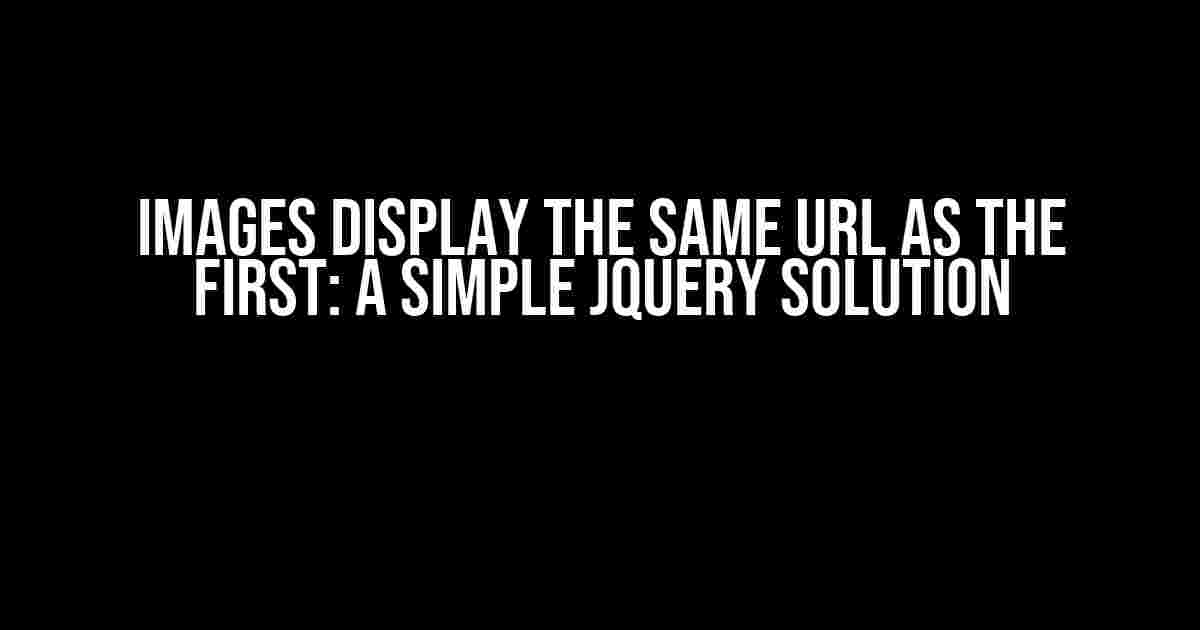When working with dynamic image displays, it’s not uncommon to encounter an issue where all images display the same URL as the first image, instead of displaying a unique URL for each image. This problem can be frustrating, especially when you’re trying to create a seamless user experience. In this article, we’ll explore a simple jQuery solution to overcome this issue.
The Problem: Images Displaying the Same URL
Imagine you’re building a slideshow or an image gallery, and you want each image to display a unique URL. However, when you inspect the HTML, you notice that all images are displaying the same URL as the first image. This can be due to various reasons, such as:
- Incorrect JavaScript code
- Missing or incorrect HTML structure
- Inconsistent data loading
Regardless of the reason, this issue can be resolved using a simple jQuery solution.
The Solution: Using jQuery to Display Dynamic Image URLs
To display dynamic image URLs, you can use the following jQuery code:
$('img').each(function(){
var imgUrl = $(this).data('url');
$(this).attr('src', imgUrl);
});
This code selects all image elements on the page, loops through each image using the each() method, and updates the src attribute with the unique URL stored in the data-url attribute.
HTML Structure
To use this jQuery code, you’ll need to ensure your HTML structure is correct. Here’s an example:
<img data-url="image1.jpg" src="" alt="Image 1">
<img data-url="image2.jpg" src="" alt="Image 2">
<img data-url="image3.jpg" src="" alt="Image 3">
In this example, each image element has a data-url attribute that stores the unique URL for each image. The src attribute is initially empty, which allows the jQuery code to update it dynamically.
Conclusion
By using this simple jQuery solution, you can easily display dynamic image URLs for each image on your webpage. This code is flexible and can be adapted to suit your specific use case, whether it’s a slideshow, image gallery, or any other application that requires dynamic image URLs. With this solution, you can ensure that each image displays a unique URL, providing a better user experience for your visitors.
Frequently Asked Question
Get the answers to your burning questions about images displaying the same URL as the first when it should display dynamically using simple jQuery.
Why are my images displaying the same URL as the first one?
This might be due to the fact that you’re using a static URL for all your images. You need to make sure that you’re updating the URL dynamically for each image using jQuery.
How can I update the URL dynamically using jQuery?
You can use the `.attr()` method in jQuery to update the `src` attribute of each image element with the correct URL. For example, `$(‘img’).attr(‘src’, ‘new-url’);`.
What if I have multiple images with different URLs?
In that case, you can use a loop to iterate through each image element and update the `src` attribute with the corresponding URL. For example, `$(‘img’).each(function() { $(this).attr(‘src’, ‘url-‘ + $(this).index()); });`.
How can I make sure that the correct URL is updated for each image?
You can use a data attribute on each image element to store the correct URL, and then use that attribute to update the `src` attribute. For example, `` and then `$(‘img’).each(function() { $(this).attr(‘src’, $(this).data(‘src’)); });`.
Is there a simpler way to achieve this without using a loop?
Yes, you can use a template engine like Handlebars or Mustache to render the images with the correct URLs. This way, you can avoid using a loop and make your code more concise.


